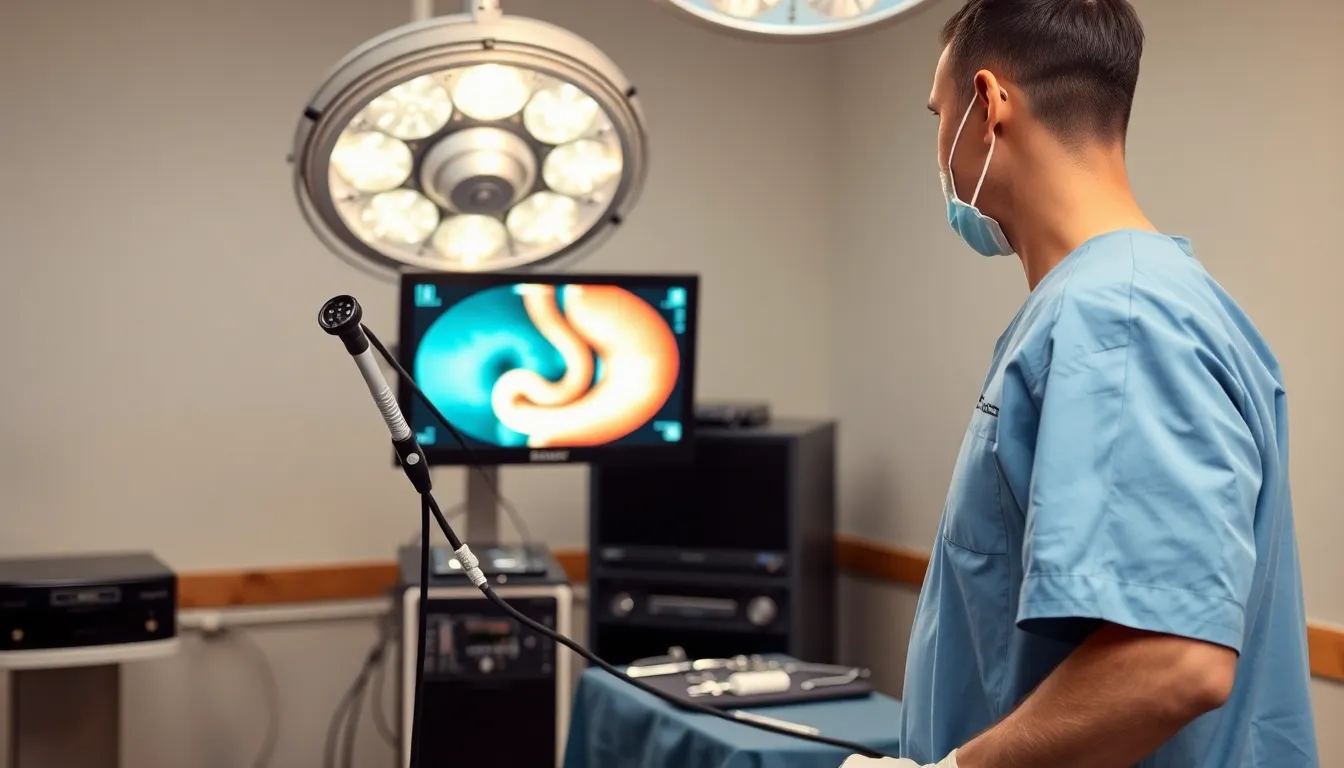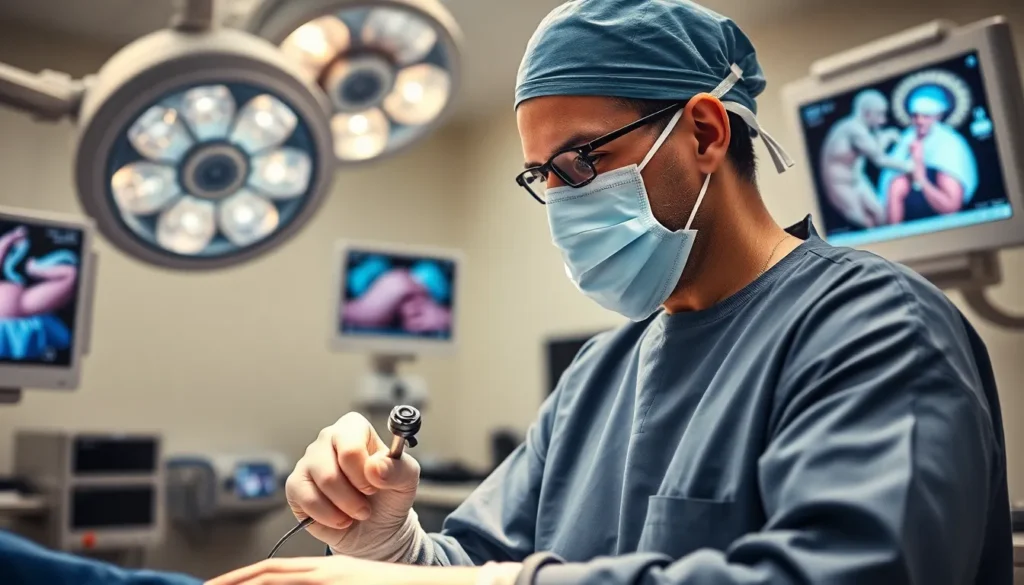Table of Contents
ToggleEndoscopic surgery might sound like a scene straight out of a sci-fi movie, but it’s very much a reality in today’s medical world. Imagine a procedure where doctors can fix problems with just a tiny camera and some fancy tools, all without making a large incision. It’s like performing surgery with the finesse of a magician pulling a rabbit out of a hat—only this rabbit is your gallbladder, and it’s got a few issues.
This minimally invasive approach not only promises quicker recoveries but also leaves patients with fewer scars and less pain. It’s no wonder that endoscopic surgery is becoming the go-to option for many procedures. So buckle up as we dive into the fascinating world of endoscopy, where precision meets innovation, and surgery gets a makeover that even Hollywood would envy.
Overview of Endoscopic Surgery
Endoscopic surgery employs a small camera and specialized instruments to perform procedures through tiny incisions. This technique allows surgeons to access hard-to-reach areas within the body with minimal disruption to surrounding tissues. Patients benefit from shorter recovery times due to reduced trauma, enabling faster return to daily activities.
Many endoscopic procedures target conditions within the gastrointestinal tract, but applications extend to other areas, including the respiratory and urinary systems. Surgeons utilize high-definition imaging to enhance precision, making it easier to identify and treat abnormalities. For instance, polyps can be removed during a colonoscopy without requiring larger abdominal surgery.
The flexibility of endoscopic surgery supports various approaches, including flexible and rigid instruments. These versatile tools adapt to specific needs during various operations. Innovations in endoscopic technology continue to emerge, enhancing safety and effectiveness. Advanced techniques, such as Endoscopic Ultrasound (EUS), allow for detailed imaging and fine-needle aspiration for biopsies.
Endoscopic surgery’s growing popularity stems from its various advantages, including less pain, reduced scarring, and lower infection rates. Patients experiencing these benefits value the quick recovery and improved quality of life post-procedure. As more healthcare professionals adopt this technique, techniques and instruments are likely to evolve, ensuring it remains at the forefront of surgical practices.
This transition towards endoscopic approaches marks a significant shift in surgical methodology. Enhanced training for surgeons fosters expert skills in endoscopic methods, promoting successful outcomes in patient care.
Types of Endoscopic Surgery

Endoscopic surgery includes various specialized techniques catering to diverse medical needs. Each type plays a crucial role in providing minimally invasive solutions.
Gastrointestinal Endoscopy
Gastrointestinal endoscopy focuses on diagnosing and treating conditions within the digestive tract. This approach uses instruments such as flexible endoscopes to visualize areas like the esophagus, stomach, and intestines. Procedures like colonoscopies and upper endoscopies allow for the removal of polyps or biopsy of suspicious lesions. High-definition cameras enhance visualization, ensuring precise interventions. This method significantly decreases recovery times and minimization of post-operative pain, making it a preferred choice for many physicians.
Urological Endoscopy
Urological endoscopy targets the urinary system, including kidneys, bladder, and urethra. It employs small cameras and tools to diagnose conditions such as kidney stones, tumors, and urinary blockages. Techniques like cystoscopy enable direct visualization and treatment within the bladder, often performed outpatient. This method minimizes the need for larger incisions and reduces complications. Quick recovery and effective symptom management contribute to its growing use among urologists.
Thoracoscopic Surgery
Thoracoscopic surgery addresses conditions within the chest, particularly affecting the lungs and pleura. Using video-assisted thoracoscopic surgery (VATS), surgeons perform procedures through small incisions while visualizing the operation on a monitor. This approach enables treatments for lung biopsies, pleural effusions, and even lung resections. Reduced pain and faster recovery characterize this method, aligning with modern surgical practices. Enhanced visualization aids accuracy, contributing to improved patient outcomes.
Benefits of Endoscopic Surgery
Endoscopic surgery offers multiple advantages, enhancing patient experiences and outcomes. Key benefits include minimally invasive techniques and faster recovery times.
Minimally Invasive Techniques
Minimally invasive techniques characterize endoscopic surgery. Surgeons use small incisions to access target areas within the body, significantly limiting tissue damage. Specialized instruments and cameras facilitate precise operations, enabling effective treatment of conditions without large openings. Scarring remains minimal, positively affecting patients’ psychological well-being. Furthermore, this precision allows for targeted interventions, such as polyp removal in gastrointestinal procedures. Enhanced visualization contributes to reduced complications during surgery. Overall, the minimally invasive nature of this approach promotes efficient healing.
Faster Recovery Times
Faster recovery times represent a critical benefit of endoscopic surgery. Patients experience significantly shorter hospital stays, often leaving the facility within a day after the procedure. Many individuals return to regular activities within days, minimizing disruptions to their lives. Less pain during recovery correlates with the reduced trauma from smaller incisions. Lower medication requirements further contribute to quicker rehabilitation. Evidence shows that many patients prefer endoscopic techniques due to these expedited recovery periods. Overall, enhanced recovery not only improves quality of life but encourages broader acceptance of endoscopic surgery in clinical practice.
Risks and Complications
Endoscopic surgery, while generally safe and effective, carries potential risks and complications that patients should understand. Awareness of these factors helps in making informed decisions regarding procedures.
Common Risks
Common risks associated with endoscopic surgery include infection, bleeding, and damage to nearby organs. An infection may occur at the incision site or within the body, leading to additional medical interventions. Bleeding can result from various factors, including vessel injury during the procedure, necessitating monitoring and potential treatment. Damage to nearby organs, although rare, could occur if instruments come into contact with unintended areas, resulting in complications or longer recovery. Adverse reactions to anesthesia also pose a risk, affecting some patients post-operation. Awareness of these risks prepares patients for possible outcomes, enhancing their engagement in the surgical process.
Long-Term Effects
Long-term effects of endoscopic surgery vary based on the procedure and individual recovery. Some individuals may experience persistent pain or discomfort at the incision site, although this often diminishes over time. Scar tissue can develop internally, which may lead to issues like obstruction in the digestive tract, requiring further evaluation or treatment. In rare cases, complications such as chronic infection or the need for additional surgeries can arise, impacting a patient’s quality of life. Permanent changes to organ function, particularly in gastrointestinal and urological endoscopic surgeries, can occur, emphasizing the importance of discussing all potential effects with healthcare providers beforehand.
Future Trends in Endoscopic Surgery
Advancements in endoscopic surgery are shaping the future of minimally invasive procedures. Innovations in robotics enhance precision during surgeries, allowing for greater control and improved outcomes. Integration of artificial intelligence provides real-time assistance, optimizing surgical techniques and decision-making for healthcare professionals.
In addition, augmented reality is revolutionizing visualization. Surgeons can overlay images on live feeds, improving their ability to analyze complex anatomical structures. Improved imaging technologies continue to reduce complications and enhance overall effectiveness, particularly in delicate areas.
Collaboration between medical and technological industries fosters the development of new tools and methods. Cutting-edge equipment, such as advanced endoscopes with improved optics, increases capabilities in diagnosis and treatment. Training programs are also evolving, emphasizing the need for comprehensive education in these new technologies.
Telemedicine presents another significant trend. Remote consultations and follow-up care streamline patient management, expanding access to specialized care. Utilizing telewound monitoring can further enhance patient outcomes, allowing for tracking recovery from the comfort of home.
Moreover, personalized medicine is gaining traction in endoscopic surgery. Tailoring procedures to individual patient needs improves effectiveness and reduces risks. Adapting techniques based on patient characteristics ensures safer, more effective treatments.
Lastly, the focus on reducing environmental impact becomes increasingly important. Sustainable practices, including single-use instruments and eco-friendly sterilization methods, promote responsible healthcare practices. As these trends develop, endoscopic surgery will continue to evolve, solidifying its role as a vital component of modern healthcare.
Endoscopic surgery represents a significant advancement in medical procedures. Its minimally invasive nature not only enhances patient comfort but also promotes quicker recoveries and improved outcomes. As technology continues to evolve with innovations like robotics and augmented reality, the precision and effectiveness of these surgeries will only increase.
Patients can benefit from tailored approaches that address their specific needs while minimizing risks. With a growing acceptance among healthcare professionals, endoscopic techniques are becoming a cornerstone of modern surgical practice. This evolution in surgical methods is set to enhance patient care and redefine the landscape of surgical treatments.







